In the first part of the material, we tried to identify the main problems of open world games that players most often complain about. It would seem that this is not the first year that part of the community has directly pointed out shortcomings to the creators. Why not try to meet the players halfway? The most obvious reason for reluctance is why experiment with financial risks when there is already a working structure that can be safely followed? After all, most are fine with it.
As we recently learned from a gamesindustry.biz survey , most newcomers to the souls-like genre are interested in Elden Ring primarily because it’s an open-world game. Of the 200 respondents, 35% (70 people) purchased the game, while 24% (48 people) had never touched FromSoftware projects before. 34 respondents out of these 48 (80%) decided to try the “soulful” series precisely for the sake of endless expanses. Although the sample is modest, the trend is still visible. The phrase “open world” itself is already an attractive advertisement for a project, regardless of implementation. And in order to create a truly thoughtful “open world”, it is necessary to solve a number of non-trivial tasks.
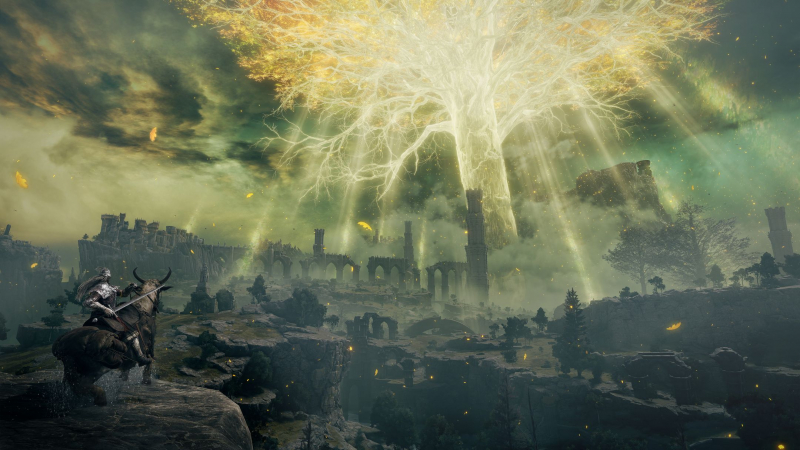
Is the world open? Sales!
⇡ # Open world challenges
As we said earlier, the open world periodically puts the player in front of a choice: which path and which destination to choose at a given time. The more such decisions need to be made, the more open the world is. This definition itself suggests that the influence of the player on the experience gained (a key result of the user’s interaction with the game) is increasing, and the influence on it from the creators themselves is decreasing.
In open-world projects, authors initially have less control over the player’s path (and, as a result, over their experience), but more opportunities to offer an assortment of tools with which to create the desired emotions for themselves. Remembering the old parable – in this case, users are offered not a fish, but a fishing rod.
The open world is primarily a road. The path of the hero that the player chooses must be unique for everyone. If the authors manage to offer a foundation for the formation of a personal adventure, then they have coped with the task. Let’s discuss what obstacles stand in the way of achieving this goal.

Journey is not an open world, but a great metaphor. The path gives rise to emotions
Freedom of movement . As we have noted more than once, the ability to choose your own path is at the heart of any open world. Whether it’s a vast ten-by-ten-kilometer field, or the intricately intertwined halls and corridors of a castle, both can be considered variants of the open world. At first glance, the concept is elementary: remove restrictions and allow you to go in any direction. However, freedom is different.
It is necessary to build a “narrative route” in order not only to tell the main story, but also to let the adventurer inside the player roam. And, most importantly, to make both components work in synergy. On the one hand, no developer wants the player to go straight to the logical end of the adventure (although not everyone forbids this), so he is distracted in every possible way. On the other hand, how many times this situation has occurred, when, according to the story being told, the hero must urgently do something … but wait a second, there are collectible items, you need to collect them so as not to return again.
You have to unobtrusively limit the player so that he does not immediately go to the final. Various tricks are used: invisible walls, enemies that are too strong (for now), locked doors (both literally and figuratively, when a certain skill is required to access a location), or even the illusion of choice. After all, the openness of the world is not an end in itself, but a means to create the necessary emotions. And if this can be achieved by a cunning trick, then the real goal has been achieved.
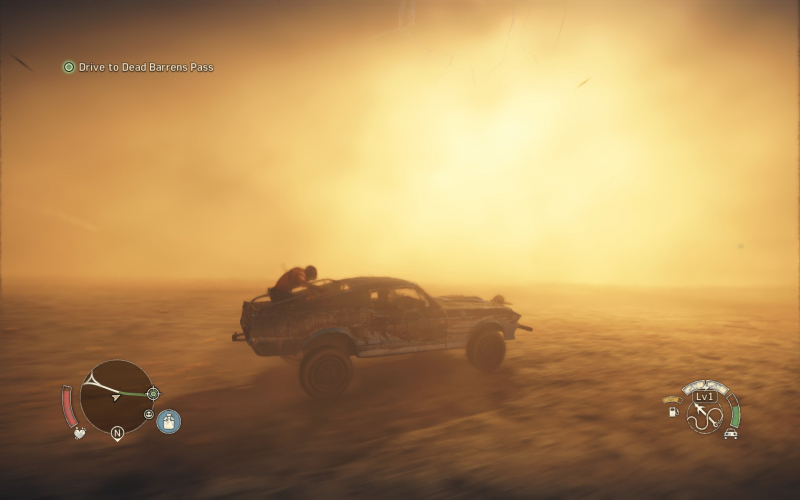
The sandstorm in Mad Max is a good example of how to limit the game world in a story-based way.
Successful implementation examples:
- The Elder Scrolls V: Skyrim . See that mountain? But seriously, the authors skillfully disposed of the system for automatically adjusting the levels of enemies and deliberately pushed the main story into the background so as not to create a conflict between plot urgency and exploration of the open spaces.
- gothic . If you look closely, the world is not so open. But the restrictions built by the narrative and the “walls” in the form of strong opponents lead the right paths so skillfully that you don’t even notice it.
Location orientation. A less obvious but extremely important feature of the open world that reinforces and enhances the effect of freedom of movement. Few manage to organically build into the virtual world a sufficient number of landmarks that unobtrusively lead the player either to points of interest or to plot events.
Receptions in game orientation can be roughly divided into two types. The first is an interface outside the game world. This is a simple and common approach: there is an interactive map, compass or arrows in the air in almost every open world, in one form or another. The second way is more intricate – to embed markers in the environment itself. Functionally, they can play the role of the same signs (like the wind in Ghost of Tsushima ), but they fit more organically into the world and enhance the immersion effect. And, obviously, they require much more labor and fine work.
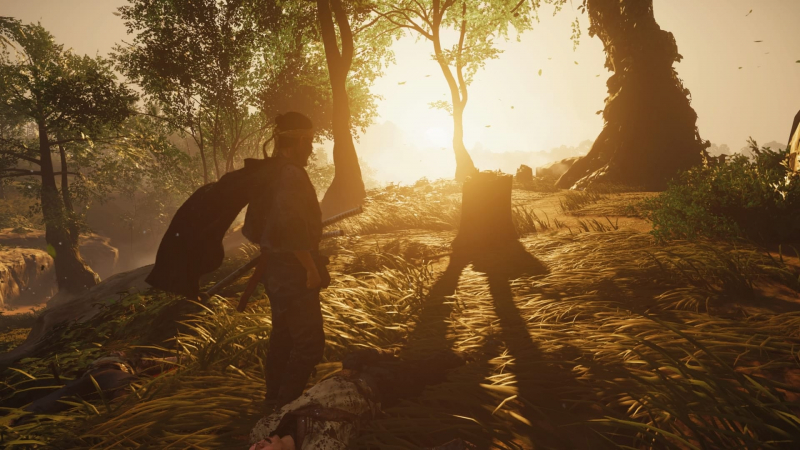
One gets the feeling that nature itself is pushing Jin to the goal.
Artists and designers need to look at the game space through the eyes of the user in order to understand what kind of landscape opens up to him. Ideally, from anywhere in the world. Titanic work. Which was perfectly executed by the creators of Legend of Zelda: Breath of the Wild . Wherever you go, the lands of Hyrule are sure to find something to attract the eye of an enthusiastic explorer.
Technical and graphical progress has greatly complicated this already difficult work in recent years. Previously, the open world looked primitive: flat plains, rough rocks, a conditional forest of sprite trees. Therefore, rare caves, lonely houses or ancient ruins easily attracted the eye, stood out from the general background. It was immediately clear – yeah, there must be something there.
Now in open-world games, the level of detail in the environment has reached such a level that it is very difficult to visually identify points of interest. This is especially true for large virtual cities: Night City ( Cyberpunk 2077 ), Paris ( Assassin’s Creed Unity ), Villedor ( Dying Light 2 ) – in such a complex area, detailed both horizontally and vertically, to bring design tricks to at least half activities are almost impossible. Markers here are a necessary measure. A universal and simple way, although it breaks the feeling of immersion. And let’s not forget about the developers’ fear of “letting go” of the player and thereby allowing him to miss some of the content.

In Night City, every house is unique.
Games about nature are easier – the beautiful, but monochromatic expanses of Breath of the Wild or Red Dead Redemption 2 contrast with points of interest. And still, you need to make a lot of effort so that the player, as if by chance (but actually not), notices interesting places on the way.
Successful implementation examples:
- The Elder Scrolls III: Morrowind . The player finds the right place thanks to textual descriptions and his ever-growing knowledge of the environment. As in the real world, any more or less significant object has its own name, which is reflected in the local literature and knowledge of virtual residents – not just a river, but the Odai River, not just a gorge, but Mameya Foyada, and so on. Neither before nor after Morrowind have games offered such a thorough immersion in the virtual universe.
- Legend of Zelda: Breath of the Wild . The authors called their approach the “rule of the triangle”: when you are at one point of interest, you always see the other two. So you always make a choice.
- Ghost of Tsushima . The “compass needle” woven into the design of the game world through the wind and plants works great for the atmosphere.
Movement process . The previous points were about the so-called meta-gameplay – the one that mostly unfolds in the player’s head. Now directly about the game mechanics. A good open world captivates not only at points of interest, but also in the way between them. Making the process of movement exciting is a more difficult task than it seems at first glance.

Even such a banal task as crossing a river can turn into an exciting adventure.
Many developers dilute the journey with collisions with opponents. Sometimes they are given a choice: fight openly or slip quietly. All this will be an active use of game mechanics. In party adventures on the road, dialogues can take place, both in the background and with the active involvement of the protagonist. The most interesting situations occur when the mechanics begin to layer on top of each other, giving rise to unique situations.
However, few of the creators remember that the very movement of the hero can be used as a mechanic that complements the feeling of freedom. The parkour system does a great job with this. Acrobatics often devolve into pressing one button, but Techland with Dying Light took a different path – performing various pirouettes requires different actions with the keyboard / mouse or controller, due to which running on the roofs turns into a continuous series of every second decisions and, as a result, easily competes in fun with the warhead. When the hero is interesting to control, the player is involved in the process constantly, every moment.
Successful implementation examples:
- Death Stranding . The road has become both the goal and the main game mechanics, in which there are no less features and opportunities than in any RPG.
- Dying Light 2 . The variable movement system requires the player to plan a route, react, and memorize the necessary key combinations.
- Marvel’s Spider-Man . Flying on the web around New York is so exciting that for the entire passage you don’t even have the thought of using fast travel.
Optional activities . Here lies one of the main claims of the broad masses to open worlds – activities are clearly categorized, and therefore predictable. To avoid the feeling of routine, a balance must be struck between the quantity and quality of the activities offered. The larger the virtual world, the more difficult it is to find this balance.
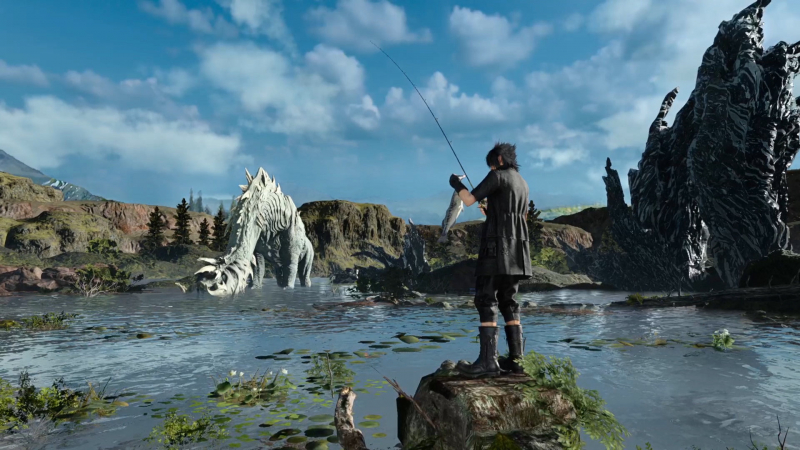
Fishing is a must in the Japanese open world game
It must be understood that the authors cannot physically come up with a hundred well-developed unique mechanics for each activity encountered. More precisely, they probably can, but the game will be released in this case at about the same time as the final version of Star Citizen. Therefore, developers are forced to limit the types of secondary activities and scatter them evenly around the map so that they alternate.
Yes, “everyone can find something for themselves here” is a marketing ploy, but look at it from the other side. The open world does not imply that it is necessary to use all its capabilities, squeeze the maximum out of it, and thereby routinize the process. Not only developers should stop being afraid that the player will miss out on some content. This also applies to the players themselves. The desire for perfectionism sometimes destroys the impression of a good project. There’s nothing wrong with skipping content you don’t care about.
Closing all the markers in Assassin’s Creed Odyssey or The Witcher 3 (oh Skellige…) is a task for the most persistent. Fortunately, in both settings you can turn off some of the “questions”. Clouds of markers in this case are really harmful – for trying to examine each tree there is a risk of not seeing the forest. Against this background, Elden Ring looks fresh, hiding the secrets of its world and not wanting the player to find everything on their own (at least in their first playthrough).
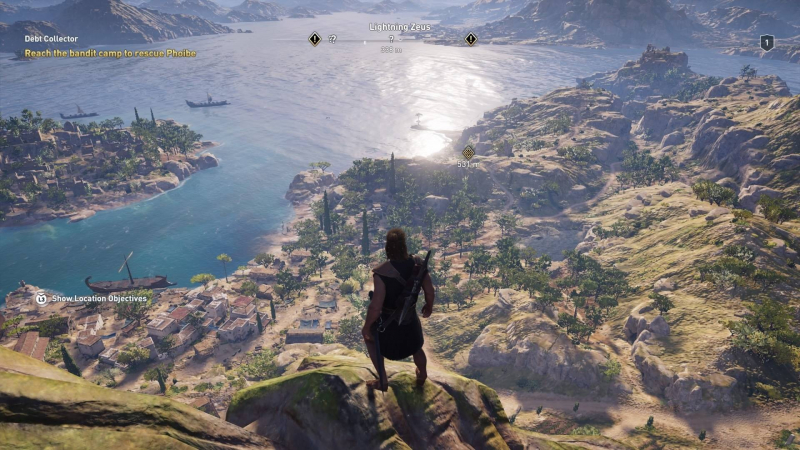
Odyssey feels much better if you turn off the markers (as much as possible) and just wander around Ancient Greece
Often there are questions about the uniqueness of activities. What’s the point of having fifty dungeons if they’re all cut to the same pattern and provide the same boring random reward in the form of generated items or resource packs? I went through one – I got all the gaming experience, and the remaining forty-nine campaigns turn into only a grind of resources. This, by the way, Elden Ring and fails. Let her activities be hidden, and the player is looking for them himself, but as soon as you notice patterns (and this happens quickly enough), the game ceases to amaze.
A good approach is taken in Assassin’s Creed Valhalla. The map displays “points of interest”, and you can roughly imagine what awaits you by color, but you rarely understand in advance what kind of event it is. In addition, there are no “courier” quests in Valhalla – all activities are allowed on the spot. They become part of the journey between story objectives and don’t pull the blanket over them. But even here it is important that the player restrain himself and not vacuum the map in order to close all the markers (or vacuum for health, if he likes it).
We must not forget about the moments of peace, when you can just take a break, contemplating the expressive landscapes. Traveling through the open world should not be clogged with minute-by-minute challenges.

In the Wild West, you can’t guess when you can be drawn into someone else’s showdown
Successful implementation examples:
- Red Dead Redemption 2 . The open world dramaturgy is almost entirely built on random events without a detailed plot background: someone is kidnapped, then robbed, then a quirky gentleman is looking for a mysteriously missing friend. Events are varied and occur at regular intervals. As soon as the player begins to yawn in the saddle, he is immediately captured by a fleeting adventure that enlivens the process.
- Assassin’s Creed Valhalla . A variety of activities are decided on a “here and now” basis – they become a natural part of the path between important plot events and try to offer something unique, whether it be a story or a puzzle.
- Arcanum: Of Steamworks and Magick Obscura . There are so many side quests scattered around the world that even after completing five playthroughs, you will find new quests, secrets, and options for the outcome of events.
The life of the world . One of the most ephemeral concepts that are fixed at the level of sensation is that the world either seems to be alive or not. But what makes it so? As history shows, not a complicated simulation at all. Gothic is still remembered as the most “living” open world, although there is absolutely nothing complicated in it. The daily routine of the NPC is elementary, there is no ecosystem living its own life, and the most difficult interaction is the guard attacks the predators that come too close.
All this (and even more) was implemented in Assassin’s Creed Origins . In it, animals squabble with each other, and people intervene, and the warriors will fight off the lions and crocodiles, and the civilians will run. Nevertheless, Assassin’s Creed is considered to be “dead and formulaic”, and Gothic – “alive and breathing”. Maybe it’s a matter of scale. When you see a couple of small settlements, and the simplest imitation of life seems realistic, but the flea market in Alexandria merges into a single NPC mass, like in any GTA-like sandbox.
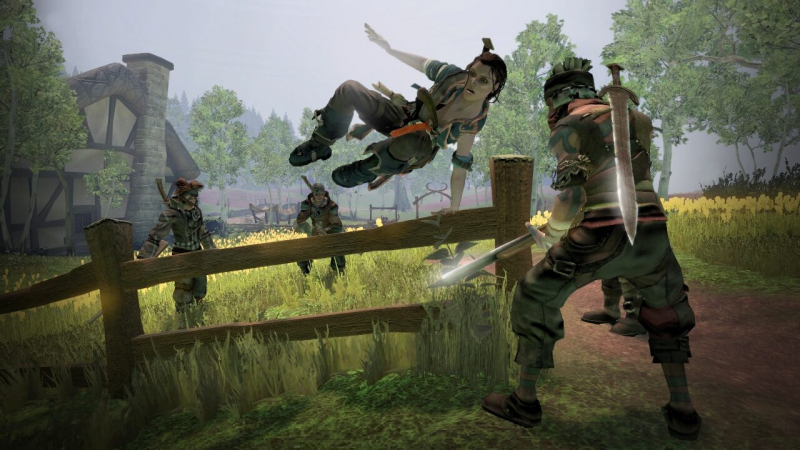
In Fable, in honor of the hero, they can even erect a statue
And does the world really need to live separately from the player? Of course, there is a certain percentage of people who care about the fact that the gears of the virtual environment rotate on their own. But in general, it looks like a waste of a lot of resources for a dubious benefit. Morrowind is great without it. It’s not the simulation in a vacuum that matters. It, like freedom of movement, is not an end in itself. It is much more important to see the reaction of the environment to the actions of the player.
It is the game’s response (in terms of plot or mechanics) to the user’s choice that makes the world feel alive. It turns out that the more choice the game gives, the more open it is. And the brighter it reacts to the perfect choice, the more alive.
Successful implementations:
- gothic . The simple simulation of the NPC schedule, coupled with hand-written moments and periodic updates after story events, created an unforgettable illusion of a living world.
- “Mor. Utopia” and Outer Wilds . Very different worlds, united by the fact that they are both interesting and do not revolve around the player. History happens on its own and regardless of whether you want to participate in it or not.
- Fable . Even though it turned out to be about twenty percent of what Peter Molyneux originally promised, Lionhead still managed to create a fairy-tale world that really tried to respond to the heroism and villainy of the protagonist.

Mora doesn’t care about the player so much that just out of principle, I want to stay in his world for as long as possible
⇡ # Infinity is not the limit
Initially, I wanted to fantasize here on the theme of an “ideal” open world. Probably, it would be an endless self-developing sandbox with the generation of unique tasks and, possibly, even entire mechanics using some kind of machine learning. But what’s the point of talking about spherical horses in a vacuum.
It is enough to remember important things. First of all, the open world is not an end in itself, but a means. A way to create a sense of wandering, to make the person in front of the screen feel like a pioneer. Allow yourself to be a part of something bigger. This does not require the technologies of tomorrow, because the developers have achieved these goals in the last century. And the pursuit of scale and detail has partly given rise to some of the problems that players are complaining about today.
What open worlds do you remember the most? We look forward to reading your stories and comments on the topic.
If you notice an error, select it with the mouse and press CTRL+ENTER.




